The Wreckers & Smugglers
"God bless feyther
and God bless mather
and God send us a wreck afore morning"
Old Wallasey Prayer
Updated: 17 Oct 2017
|
|
Although mostly associated with Cornwall, smuggling was a common occupation in poor seaside communities along all the coasts of Britain. Like many forms of crimes, it came about as the result of legislature, when Edward 1 placed a customs duty of wool exports to Europe, a duty that increased throughout the Hundred Years War, in order to fund the kings attempts to become King of France. he customs service was primarily concerned with collecting duties, but as time went on, illegal trade increased, particularly in the 17th and 18th centuries when smuggling reached industrial proportions. Wool exports were criminalised in 1614, and made punishable by death in 1661. Smugglers began to arm themselves against the dreaded Revenue men, who were soon provided with 'cutters' to patrol the coasts. (Wirral Smugglers, Wreckers & Pirates - Gavin Chappell)
A British Naval Officer once remarked to a fellow: "There's not a Cornish jury in the land that will convict a smuggler. A wrecker is another matter." and how true was that remark? Wallasey forms the northerly corner of the Wirral and has always been somewhat remote from the remainder of the Wirral. A town without a centre, visitors had difficulty finding their way about, locals prided themselves in being a breed apart. In the 18th and 19th Centuries all of North Wirral was remote and cut off from more densely populated areas. Wallasey was more isolated than most and it gained a notorious reputation as a haunt of smugglers and pirates. The headquarters of local smuggling was a house that once stood on the river front between Lincoln Drive and Caithness Drive on what is now Egremont Promenade. Built in 1595 by one of the Mainwaring family beside what was at that time Liscard Moor, on the high water mark of the River Mersey, it went through a number of different names including the Half Way House, The Whitehouse and Seabank Nook. Next to it were 3 houses, some of which remain, called Seabank Cottages. The house became a tavern during the American War of Independence, when American and English privateers roamed the ocean and John Paul Jones raided Whitehaven in Cumbria. The tavern gained the nick name Mother Redcap's after Poll Jones, who always worse a red cap or bonnet. more about Redcaps at the link. Its normal title was The Half Way House. It was officially this until late into the 19th century. |
|
One of the ports of call of the Smugglers
transferring contraband across Bidston Moss was the Ring 'o Bells, now Stone
Farm, in Bidston. Owned by a local family, some say the Radley's, others the
Pendleton's. In the mid 19th Century Mary Radley or Pendleton married a
Simon Croft under which the Ring 'o Bells became as notorious as Mother
Redcap's. It also had a well established reputation for Ham 'n Eggs! It is
described in The Adventures of Christopher Tadpole! Simon Croft kept his own
pigs but became something of a drunkard. A lively and mixed crowd used the
establishment including prize fighters Tom Sayers, Jem Mace and 'Tipton
Slasher'. Four years after his death, in 1864, Lady Cust (Leasowe
Castle) prevailed upon Squire Vyner, the lord of the manor, to revoke the
licence.
Bidston
has been 'dry' ever since. On occasion revenue men may be found to be waiting near the moss for contraband. In such cases, the contraband was taken along the edge of the Moss and around to Saughall Massie, to a Mill, which stood in what is now Action Lane, Moreton. One such tale relates that a revenue man lay in wait as he had been tipped off that two barrels of rum were to be carried that night across the Moss to the Ring 'o Bells. As the carter approached the Revenue man leapt out of hiding and challenged the carter. You have rum in those kegs!! Nay, Its ale - the Ring o' Bells (image right) has run out and I'm taking them some. On checking contents, it was indeed ale. The smugglers had got wind of the revenue man and switched the rum barrels for ale!! Another instance was when Revenue men saw two men removing bales from the area of a wreck. After a pursuit, the bales were found to contain cabbages and ferns. The real stolen bales had vanished by the time the Revenue men returned to the shore. Mother Redcaps finally closed it doors in 1960 after an unsuccessful short lived nightclub venture, and was demolished in October 1974. During demolition the famous 'smuggler's well' was discovered by the workmen, they found lots of bottles, jars and flagons and they wanted to inform the museum authorities! The foreman insisted that the 'hole' be filled in and a treasure of lost artefacts, found, were lost again. He threatened to sack anybody who told the museum! Sadly there are too many of these short sighted idiots around and much has been destroyed here and elsewhere that could have been saved. Maybe the foreman had found something he would rather not be made public? Who knows?
Information taken from
Wirral
Smugglers, Wreckers & Pirates, a 2009 publication by Gavin Chappell and printed
with permission. |
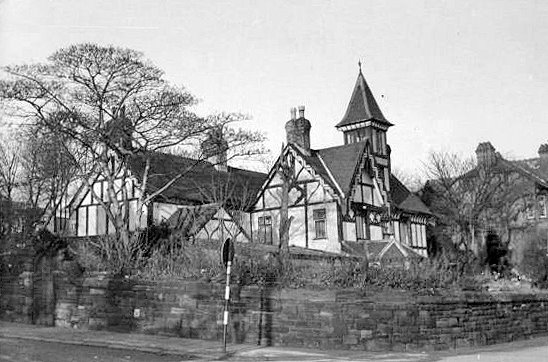 Mother Redcap's and (below) formerly the Ring 'o Bells Bidston 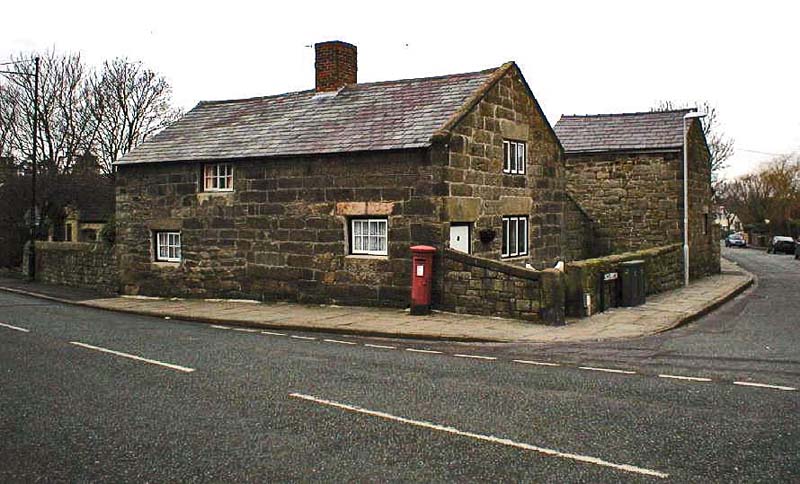 |
|
The prayer of the Wirral Wreckers was tragically answered on many occasions. At the foot of the old Wallasey Parish Church tower lie two weather worn and almost forgotten gravestones, concealing a tale of one such shipwreck on the Wirral shore. An apt resting place, looking out, as it does, over Leasowe Castle and the Wirral shore, the waters of Liverpool Bay and the very sandbank where disaster struck. On Christmas Day, 1838, the packet ship "Pennsylvania" set sail from Liverpool bound for New York. She proceeded to the mouth of the Mersey to await the first favourable wind. She was a superior and fast sailing freight carrying vessel, with cabins commodious and elegantly fitted. On this voyage there were 40 people on board, of which 5 were passengers. On the 12th day of Christmas, a Sunday, she finally put to sea on her fatal voyage. It was 10.30am and there was already a strong wind blowing from the southeast. The ship had a good run as far as Point Lynas, off Anglesey, which she reached by 9pm. Then she was totally becalmed for some 10 minutes, the proverbial lull before the storm. The wind freshened from the southeast, and soon after midnight the Pennsylvania was in the midst of a hurricane. It was the 13th day of Christmas. The storm continued unabated throughout the Monday. About the Pennsylvania efforts were made to clear the damage, and turn the ship about. When daylight came on Tuesday, Captain Smith, her Commander, tried to put back to Liverpool. On reaching Ormes Head, a course was plotted for the Mersey Lightship. Unknown to the Pennsylvania, however, the floating light had parted from its mooring the previous day. Normally it was anchored off the East Hoyle Bank to help guide mariners safely into the Horse and Rock Channels. The newspapers of the time were suspicious: "To say the violence of the gale drove her from her moorings is absurd. The floating light ......... makes its appearance ......... so regularly in the Mersey with every onslaught of the elements ...... (that one might suspect) that those who tended it felt so deeply for their own personal safety in times of danger that they quit their post. Again, during the past gale when most needed to guide vessels in distress, has this vessel parted her moorings. It is scarcely two months since she parted her moorings before a gale and came into port. To us this is very extraordinary and inexplicable" The Pennsylvania still bewildered by the absence of the Lightship, dropped anchor off Hoylake, about three miles from the shore. It was now 1.30pm on Tuesday. Before another anchor could be dropped however, the vessel swung around, drifted, and struck the Hoyle Bank. The force of the gale rammed her into the bank 8 or 9 times, and she started to take on water rapidly. Strangely, two other packet ships, the St Andrew and the Lockwoods also struck the Bank, not more than half a mile apart. One cannot help but recall the words of James Stonehouse, writing in 1863: "Many a fierce fire has been lighted on the Wirral shore on stormy nights to lure the good ship onto the Burbo or Hoyle Banks, there to beat and strain and throb, until her timbers parted ......." In an attempt to reach the shore, the Pennsylvania's jolly boat was launched into the gale. Aboard it were 5 passengers, including one William Douglas, as well as the Chief Mate, Lucas B Blydenburgh, and several of the crew. Those worn gravestones in a Wallasey churchyard tell only too well the fate of that little boat. Only one of its occupants survived. Meanwhile back on the wreck of the Pennsylvania, the long boat, the only other prospect of escape, was lost in heavy waves, which also swept the Captain overboard. It was 3pm Tuesday. Much of the hull was now underwater. The remaining crew climbed desperately into the rigging where they were to cling for dear life for 19 hours. It was not until 10 am the next day that the steam tug Victoria took them off, except that is, three of the crew who had literally been starved to death of cold and hunger in the rigging during the night. 21 were saved from the wreck, 19 drowned. From the wreckers of the Wirral shore, the storm had come as a belated Christmas present. Liverpool newspapers commented: "We lament to find that these infamous wretches, the wreckers, have been at their fiendlike occupation, plundering what the elements have spared, instead of seeking to alleviate the calamities of their fellow creatures. The wreckers who infest the Cheshire coast were not long in rendering the catastrophe a source of emolument to themselves. The property of the passengers and crew where plundered by them to an alarming extent. The Steward, who had in his trunk sixty watches and other articles of jewellery, found on regaining the vessel that the whole had disappeared". Some reports placed the value of the cargoes carried by the Pennsylvania and St Andrew as high as £400,000, so it is hardly surprising that the wreckers chose the Pennsylvania as their "especial prey". The Pennsylvania had suffered most, her state cabin has almost entirely been stripped. A number of plunderers were, however, taken into custody. One in particular, a John Bibby, boatman, is worthy of our interest. When apprehended he was found to have forty yards of new cloth, valued at £12, folded round his body. In his fishing boat were found books, a large and handsome cruet stand, a black coat, a pair of trousers, a pair of drawers and much else. It transpired that the coat had belonged to the late Captain Smith and the cruet stand to the same ship. The trousers belonged to Mr Thompson, its sole surviving passenger. The owner of the drawers was never ascertained. Bibby claimed in court that the cloth had been given him by a man on the Pier Head. Nor had he any idea how the other articles had found their way into his boat. He was fined £27. In default of payment he was to be jailed for 6 months. He might have considered himself lucky, for it was an age when a not unknown penalty for wrecking was public whipping or even transportation. William Douglas, one of the 5 passengers, who along with the First and Second Mates, tried to escape from the wreck. However, the ill fated boat did not live long in the tempest. About midway between the vessel and shore, she swamped, and all on board were thrown into the sea. He succeeded in reaching the shore, he was immediately taken to Leasowe Castle but he only survived a short time. The Captain and First and Second Mates were also drowned. It was thus reported, "His mortal remains (Lucas Blydenburgh) were attended to the grave by all American Captains in port, as well as by hundreds of seamen. The sight was most mournful." The Inscription reads: "Sacred to the
memory of Lucas B Blydenburgh of New York, Mate of the Packet Ship Pennsylvania, |
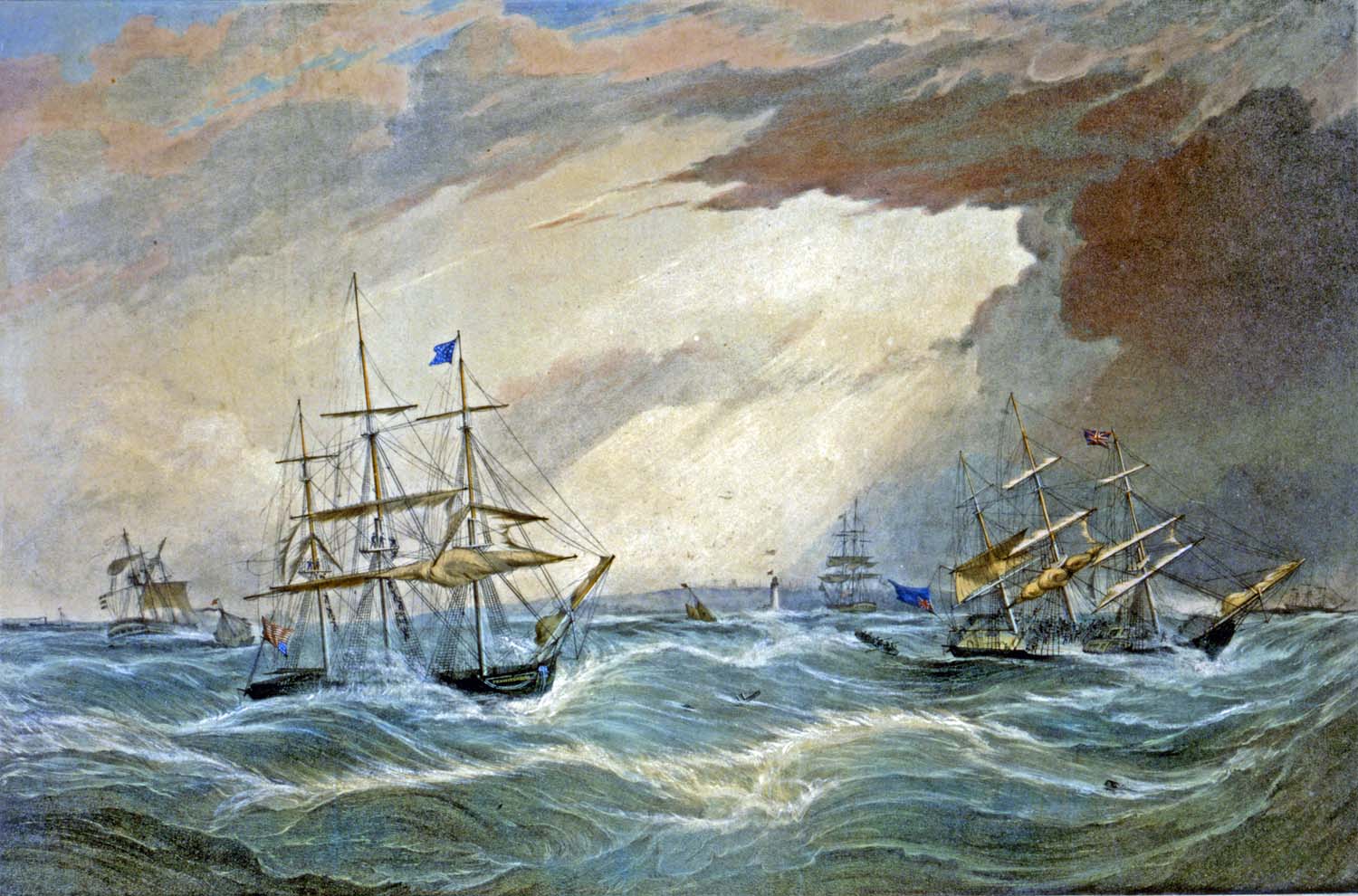 Uss Pennsylvania off the Wirral Coast  It reads: The loss of the Pennsylvania, New York Packet Ship, the Lockwoods Emigrant ship, the Saint Andrew Packet ship and the Victoria from Charleston, near Liverpool, during the hurricane on Monday & Tuesday Jany 7th & 8th 1839. Also the Ward from St Johns at anchor; the Victoria Steam Tug towing the Lifeboat and the Mountaineer steamer, with a view of Leasowe Lighthouse & Bidston Hill. This print is intended to represent the vessels shortly after they struck on the Tuesday afternoon from particulars given to the artist by Captain Sprowle of The Lockwoods; Captain Thompson of the Saint Andrew and by Captain Candler of the Victoria. (The perspective of the painting is as if the artist was out to sea, off Mockbeggar Wharf, looking back towards the Wirral. The River Mersey is to the left, the Dee off to the right - mk). 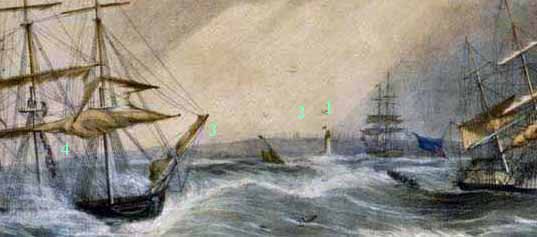 The artists viewpoint is obviously on the Mockbeggar Banks but has a section missing. Figure 1 is Leasowe Lighthouse and Figure 3 is Leasowe Castle whilst 4 is in the general direction of New Brighton and the mouth of the Mersey. But Figure 2 should be the Observatory/Lighthouse on Bidston Hill. On a line of sight from the imagined viewpoint of the artist this would make sense but then he has missed out Wallasey Brow and St Hilary's Church. The darker patch behind the ailing ship on the left is too low. 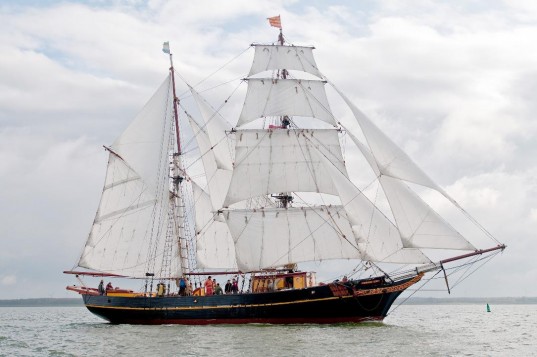 Example of a Brigantine The Elizabeth Buckham was a brigantine built by Whiteside & Scott at Whitehaven in 1837.  Many myths and superstitions surrounded the pirates and smugglers. These tales were deliberately put about to make 'decent folk' stay away from certain areas. |
|
Max Moeller Director of Research Services The Historical Society of Pennsylvania 1300 Locust St. Philadelphia, PA 19107 has replied to a question from me asking about ships images, he states that:
I have found two images reproduced in published sources (both of which should still be available in bookstores) of the U.S. Ship Pennsylvania . Neither of the originals are owned by HSP. They are: Launch of the U.S. Ship Pennsylvania, a wood engraving by R.S. Gilbert, July 1837 private collection (reproduction found on page 271 of Russell Weigleys Philadelphia: A 300 Year History, 1982); and View of the Launch of the U.S. Ship of War Pennsylvania, lithograph by Lehman & Duval after G. Lehman, 1837 Library of Congress (reproduction in Edwin Wolfes Philadelphia: Portrait of an American City, 1990). The following extract is taken from the book "Portrait of Wirral" by "Kenneth Burnley". One hundred and fifty years ago this stretch of coast was renowned for its wreckers; robbers and smugglers who would lure the Liverpool-bound vessels on to the sandbanks using decoy lights and flares. Once ashore, the wreckers showed no mercy towards the unfortunate crew and passengers; if their lives were spared, their cargoes and belongings were not. But not all wrecking was deliberate; winter storms claimed many ships, and local people were quick to arrive on the scene to salvage what they could. Henry Aspinall, of Birkenhead, wrote this vivid description of a severe storm in 1839: On 6th January 1839, the day was fine; a fair wind blew for outward-bound ships. Many left the Mersey under sail, among them the St Andrew, the Lockwoods, and the Pennsylvania, first class packet ships, loaded with valuable cargoes and emigrants together with a few saloon passengers for New York. On the morning of the 7th, the barometer fell to a very low point. The vessels had almost reached Holyhead, when suddenly the wind changed to the north-west and blew a hurricane. The three vessels at once put back for the Mersey, the only shelter in such a gale. Unfortunately the wind veered dead north-west, and took the three vessels on to the Burbo and West Hoyle Banks. The sea rose to a fearful height, and the vessels settled in the sand until they were literally smashed to pieces. No boats could live. The moment they reached the water they were swamped and all on board were washed away. Many were drowned and washed ashore at Leasowe, Hoylake, and the neighbouring coast. Such a sight I never saw before or since, nor should I like to. The scene deeply impressed. The beach was covered with wreckage and dead bodies. I vividly recall the latter . . it was, indeed, a most pitiful sight. To this day, in old Hoylake cottages, may be seen cupboards, doors, satinwood fittings, and glass and ebony door handles, washed up and appropriated by the finders, sad relics of a catastrophe which caused a great sensation in the district. After a long time of searching for images of this ship I was contacted by Ron Blyden (Nov 06) who provided me with this artists "impression" of the fateful events described above. He also provided me with a link to another painting, by the same artist, of the ship coming into Liverpool, passing Perch Rock. I am unable to obtain a copy of this image. Thanks to Ron, a descendant of Lucas Blydenburg. I did a a "cleaned up" version of the original browned image.
|
The Guardian, 28th November 1866, page 3;
" GALE
OFF LIVERPOOL, AND LOSS OF LIFE : LIVERPOOL, TUESDAY : Last
night, and up to an early hour this morning, a severe gale from
the north-west prevailed outside this port, the town itself
being almost free from the effects of the storm. At Holyhead,
however, and other stations on the Welsh coast, the gale was
felt with much severity, and it is feared that numerous shipping
disasters will be reported. One disastrous wreck was announced
here today. The brig Elizabeth Buckham, Captain Wylie,
bound from Demerara to this port, with a cargo of rum, sugar,
and cocoanuts, has been totally wrecked on the Great Burbo Bank,
at the entrance to the port, and all on board have perished. It
appears that about ten o'clock last night, as the steam tug
Rattler was returning to port, the captain saw a brig
drifting down upon the Great Benbo Bank, and almost immediately
afterwards she struck with a tremendous crash on one of the
elbows of the Benbo. The steam tug attempted to reach the
distressed vessel, but all endeavours were in vain, owing to the
fearful sea which broke continually over the bank. After lying
to for some time, during which the foremast was observed to
'go', and cries for assistance were heard, the Rattler at
once made for port, and at 12 30 a.m. started for the scene of
the calamity with one of the lifeboats in tow. On reaching the
vicinity of the wreck the boat was cast adrift, and after
searching the bank for several hours no human being was to be
seen - the quantity of wreck, &c. floating about showing too
clearly that the work of destruction must have been very rapid.
After a fruitless search the Rattler and the lifeboat
returned to port. Immediately afterwards two other steam tugs,
the Talbot and the Warrior, arrived here from
Preston, and both vessels reported having passed through a great
quantity of wreck in the Formby Channel. The ill-fated brig was
242 tons burthen, and was built as far back as 1837, at
Whitehaven, and had, we understand, been engaged for several
years in the West India trade. She was consigned to
Messrs.Booker and Co. of Liverpool, having called two days
previous at Queenstown for water, &c. For several miles along
the Welsh coast large quantities of wreck, cocoanuts, and other
articles belonging to the brig, strew the beach. One of the
boats of the brig has been found at Hoylake, and in the same
neighbourhood several puncheons of rum have also been picked up.
A singular coincidence in connection with the wreck of the
Elizabeth Buckham has transpired. About a year ago, a vessel
called the
Favourite (belonging to J Richardson Thompson of
Whitehaven), bound from Demerara to Liverpool with a similar
cargo, was totally wrecked on the exact same spot which proved
so disastrous to the brig."
No bodies came ashore from the wreck, nor did any of her timbers for several
months after. Her log-book floated ashore at Wallasey which proved her to be the
brig Elizabeth Buckham, 242 tons register, built at Whitehaven in 1839, owned by
Mr J. Thompson Richardson of that place and commanded by Captain T. Wylie. Before the tax
on salt was removed in 1825 large quantities of it were smuggled. That this part of the coast in the past enjoyed a very sinister reputation for wrecking and similar offences may be gathered from an extract from the report of the Royal Commission for enquiring into the establishment of a Police Force in England in 1839. The County of Cheshire was said to be, with Cornwall, the worst in the kingdom for wreckers, and it was stated "that on the Cheshire coast not far from Liverpool, they will rob those who have escaped the perils of the sea and come safe on shore and will mutilate dead bodies, for the sake of rings and personal ornaments.". Stonehouse, writing in 1863, states: Stonehouse was describing the Wirral of his youth. By the mid nineteenth century the wild North Wirral coast had been tamed: a rural constabulary had been established, stretches of impenetrable marsh and moor had been bridged or drained, and Gladstones free trade policy had rendered smuggling unprofitable. Although wreckers of Wallasey were yet to defy the law, three years for one last great orgy of drinking after the wreck of the Elizabeth Buckham, the smugglers and privateers who had once gathered in Mother Redcaps were long gone, and the latest owner had cancelled the licence. The Liverpool merchants who had most from the activities of wreckers and smugglers were now beginning to settle in once notorious villages such as Heswall and Hoylake, transforming former nests of piracy into leafy Victorian suburbs. Walking through the genteel environs of Lower Heswall, It is hard to imagine that one of the most expensive postcodes the country covers an area that was once a centre of crime, smuggling even massacre if tradition is to be believed. (Wirral Smugglers, Wreckers & Pirates - Gavin Chappell) |
|
By the eighteenth century the problem had reached such an extent that entire communities were dependent on smuggling. When the free-trade was prevented in the Scilly Isles, the islanders faced famine - their livelihood had been taken from them. Smuggling thrived during the hardships of the wars with France, and due to the fighting on the continent the government had few men available to prevent it. It was a different story after the end of the Napoleonic Wars in 1815. The government's war against smuggling increased, and the Coastguard was introduced. Smuggling became less and less viable. The last nail in its coffin came in the 1840s when the Liberal government adopted a free trade policy. Now that 'free-trade' was no longer a criminal occupation but a government policy, smuggling became unprofitable and the smugglers lost their livelihood. Smuggling in Wirral was most prevalent in two main areas: Wallasey, with its nerve centre at the coastal tavern owned by 'Mother Redcap,' from which point illicit goods were transported inland across Bidston Moss, or underground through tunnels carved in the sandstone rock; and the Parkgate/Heswall district, where the locals smuggled in contraband under the noses of customs officers at Parkgate and Dawpool, through the Heswall Dales, or along smugglers' tunnels under Thurstaston. (Wirral Smugglers, Wreckers & Pirates - Gavin Chappell). Hoylake and Hilbre Island were also linked with smuggling, but little is known about this practice there. Gavin Chappell, in Ch 1, gives us a fair insight into the Heswall area practises. Formby, on the Lancashire side, was a great place for smugglers. I dont think they wrecked as the Cheshire people did, the latter were very fiends. (James Stonehouse). The Formby fishermen were pretty honest and hard-working and could always make a good living by their calling, so that the smuggling that they did was nothing to be compared to their Cheshire compatriots? The fishermen of Hoylake were always ready to board either in-bound or out-bound vessels from which they could obtain excisable articles for the purpose of running them. The story may be truth or myth, that a parson, once minister to the old church at Wallasey, was as much addicted to wrecking as any of his congregation, and who would cry from his pulpit when news of a wreck was brought during service time: "Now, friends, wait till I get down from my pulpit and doff my gown, and then we all start fair", and he would head the stampede across the sandhills. To show the truth of what Stonehouse says, the description
of the fate of the schooner Mary Betsy which sailed from Wexford on 24th October
1820, will suffice. The scenes that followed the wreck of the brig Elizabeth Buckham (image above) on 26th November 1866 have been graphically described by Mr Bertram Furniss: She went ashore and broke up before assistance could be rendered. Laden with rum and coconuts which floated ashore and were soon taken possession of by inhabitants. On the shore casks of rum were broached; some carried the spirit to their houses, others drank it on the spot, fights ensued, and the whole police force of Wallasey (five in number), was quite inadequate to cope with the tumult. Towards evening they were fully occupied lifting the sleeping carousers to a safe place above high-water mark to prevent their being drowned by the rising tide. At least two deaths occurred, one the boots at the Victoria Hotel. At the inquest Coroner Churton referred to the prayer at the head of this page and added that on one occasion, when a wreck was reported while the congregation at Old St Hilary was listening to the sermon, the rector said to those who were moving prematurely towards the door, Keep your seats till after the collection and then we can all start fair. A slight variation only on the tale related earlier, if indeed any of it is true? Following on from a particular wrecking in 1758, it was reported that "the whole of the North Wales coast and Wirral peninsula, was roaring drunk after a vessel with a huge cargo of wines and spirits ran aground on the welsh approaches to Liverpool." The name of the vessel is not yet known by me. |
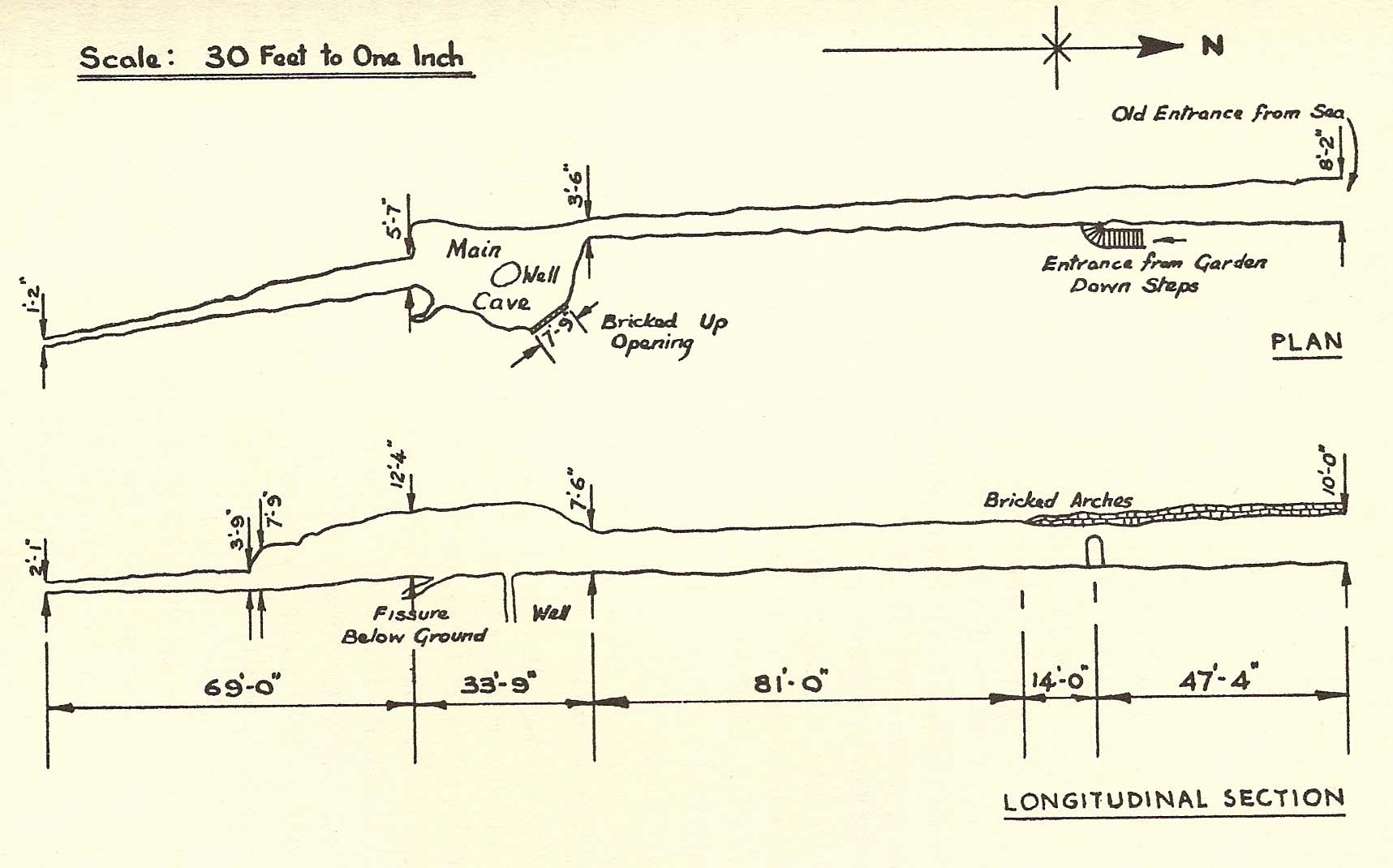 Yellow Noses Map and Image (2008)  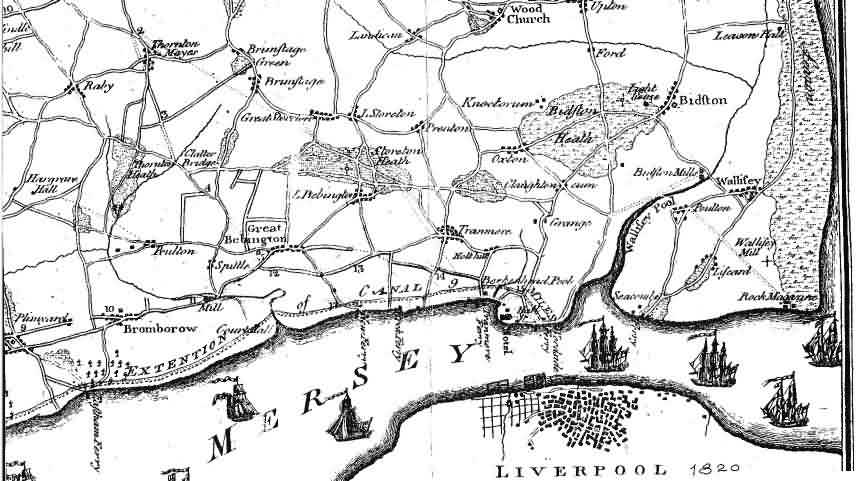 The Wirral of John Stonehouse 1820  Schooner founders, similar to Mary Betsy |
| It is worthy of note that tunnel tales abound in the Irby & Heswall areas. A supposed tunnel lead from what is now the Irby Club (formerly the Rookery) to Irby Hall and another from the Hall to Thurstaston Hall. The revenue men were also strongly suspected of murdering smugglers wives. The Revenue men heard voices from the direction of a cave. They did not know it was the smuggler's wives, waiting their return. Creeping up the shot everyone in site. Realised their mistake and fled, leaving the bodies for the smugglers to find. This story was allegedly reporting in a local newpaper in 1840, but no records can be found. However it could only have been revenue men, as they alone carried firearms. The revenue men kept quiet but no inquiry was held and they took their cowardly deed to their own graves. |  |
| CONTACT |
Wallasey Videos:
http://www.youtube.com/watch?v=gH59hHwDxZc&feature=youtu.be
http://www.youtube.com/watch?v=nmw8yIlVsUU&feature=related
http://www.youtube.com/watch?v=zciRmnvQAVA&feature=related
http://www.youtube.com/watch?v=FBjpUkH1Uuw&feature=related